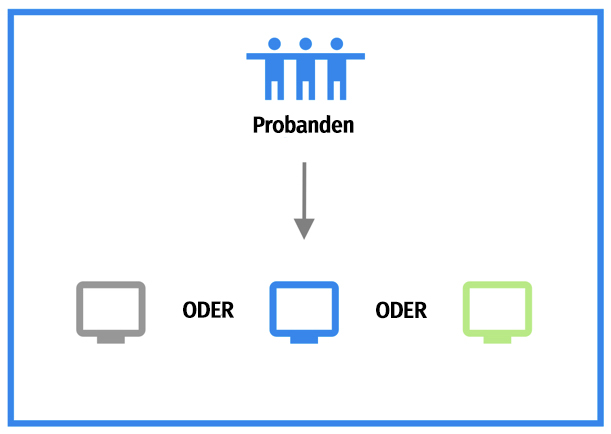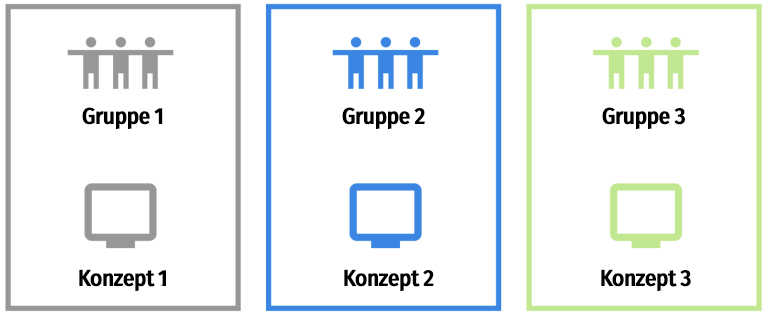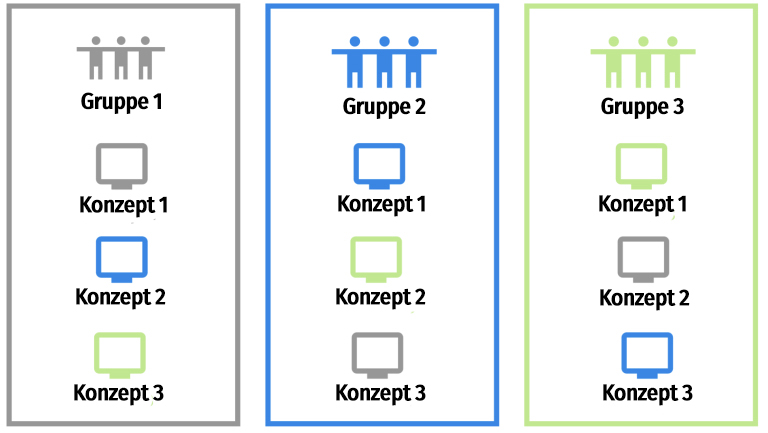Marktforschung
Vergleichender Konzepttest, monadischer Konzepttest und sequentiell-monadischer Konzepttest. Was genau ein Konzepttest ist und wie Sie Konzepttests durchführen erfahren Sie in diesem Blogartikel.
Content
- 1 Was ist ein Konzepttest?
- 2 Beispiele fürAnwendungsfälle von Konzepttests
- 3 Beispiele für gute Konzepttests innovativer Unternehmen
- 4 1:1 Live Online-Präsentation: Konzepttest durchführen mit QuestionPro
- 5 Marktforschungs-Software zur Durchführung von Konzepttests jetzt 10 Tage kostenlos testen!
Was ist ein Konzepttest?
Ein Konzepttest (Concept Testing) kann verstanden werden als die Prüfung einer Idee unter Zuhilfenahme wissenschaftlicher qualitativer und quantitativer Befragungs- und Bewertungsmethoden im Rahmen der Marktforschung. Hierbei beurteilen und bewerten Verbraucher in einer frühen Phase der Produktentwicklung, in der das Produkt den Status eines Konzeptes, einer Idee noch nicht überschritten hat, eben diese Idee bzw. das Produktkonzept. Die Weiterentwicklung einer Produktidee erfolgt nach einer positiven Bewertung des Konzeptes seitens der Verbraucher und wird bei entsprechender negativer Bewertung verworfen. Es geht also kurzum um die Bewertung der Verbraucherakzeptanz einer neuen Produktidee. Hierbei wird eine Produktidee so weit erarbeitet und entwickelt, dass der Nutzen des Produktes den Teilnehmern an einem Konzepttest bereits dargestellt und vermittelt werden kann, damit Verbraucher diese Idee entsprechend beurteilen und bewerten können.
Bei der Durchführung von Studien und Tests im Rahmen der Marktforschung ist es wichtig, die Forschungsmethode zu wählen, die am besten zu Ihren Zielen passt und die entsprechend besten Ergebnisse liefert. Wenn Sie eine Umfrage zum Testen eines Konzepts, eines Produkts oder einer Werbekampagne erstellen, gibt unterschiedliche Arten und Formen von Methoden, die Sie verwenden können:
- vergleichender Test
- monadischer Test
- sequentiell-monadischer Test
Vergleichender Konzepttest
Bei einem vergleichenden Konzepttest beurteilet und bewertet eine Gruppe von Probanden oder Umfrageteilnehmer zwei oder mehrere Konzepte und bringen diese in eine Rangfolge oder aber wählen das bevorzugte Konzept aus.

Vorteile des vergleichenden Konzepttests
Vergleichstests sind recht einfach durchzuführen und liefern Ergebnisse, die leicht verständlich sind. Es gibt einen klaren “Sieger” unter den Konzepten, da die Probanden oder Umfrageteilnehmer das für sie beste Konzept benennen und es hier eine klare Rangfolge gibt.
Nachteile des vergleichenden Konzepttests
Obwohl die Ergebnisse eines Vergleichstests leicht verdaulich sind, bieten sie selten einen wirklichen Kontext über die wahre Attraktivität eines Konzepts. Möglicherweise gibt es ein spezifisches Detail oder besondere Merkmale eines unterlegenen Konzeptes, das für die Probanden oder Umfrageteilnehmer attraktiv ist aber nicht einzeln bewertet werden können, da die Konzepte in der Ganzheit bewertet werden.
Durchführung eines vergleichenden Konzepttests
Hier erfahren Sie, wie Sie mit der Marktforschungs-Plattform QuestionPro einen vergleichenden Konzepttest durchführen.
→ vergleichenden Konzepttest durchführen
Monadischer Konzepttest
Bei einem monadischen Konzepttest werden Probanden oder Umfrageteilnehmer in mehrere Gruppen unterteilt, wobei jede Gruppe ein bestimmtes Konzept testet.

Vorteile des monadischen Konzepttests
Das sich die Probanden oder Umfrageteilnehmer mit nur einem einzigen Konzept befassen können Marktforscher tiefere Einsichten auch zu einzelnen Merkmalen und Details eines Konzeptes erhalten.
Nachteile des monadischen Konzepttests
Eines der wesentlichen Nachteile des vergleichenden Konzepttests ist, dass aufgrund der Einteilung in Gruppen sowie der Fokussierung der Probanden oder Umfrageteilnehmer auf jeweils ein Konzept entsprechend mehr Probanden gefunden werden müssen, was sich auf die Kosten auswirkt.
Durchführung eines monadischen Konzepttests
Hier erfahren Sie, wie Sie mit der Marktforschungs-Plattform QuestionPro einen monadischen Konzepttest durchführen.
→ monadischen Konzepttest durchführen
Sequentiell-monadischer Konzepttest
Bei einem sequentiell-monadischen Test bewerten und beurteilen Probanden oder Umfrageteilnehmer zwei oder mehrere Konzepte unabhängig voneinander. Die Konzepte werden in einer zufälligen Reihenfolge präsentiert, um eine Verzerrung zu vermeiden.

Vorteile des sequentiell-monadischen Konzepttests
Da jedem Probanden oder Umfrageteilnehmer mindestens zwei Konzepte gezeigt werden, sinkt die erforderliche Stichprobengröße, wodurch der Konzepttest kostengünstiger wird. Weniger Befragte bedeuten auch, dass weniger Zeit für die Durchführung der Umfrage und die Datenerfassung benötigt wird. Zudem gewinnen Marktforscher wesentlich mehr Daten zu den jeweiligen Konzepten.
Nachteile des sequentiell-monadischen Konzepttests
Die gleichzeitige Präsentation mehrerer Konzepte macht den Konzepttest für Probanden oder Umfrageteilnehmer umfangreicher, was sich auf die Abschlussrate der Umfrage auswirken und das Risiko einer Verzerrung durch Nichtbeantwortung oder unmotivierte Beantwortung der birgt.
Durchführung eines sequentiell-monadischen Konzepttests
Hier erfahren Sie, wie Sie mit der Marktforschungs-Plattform QuestionPro einen monadischen Konzepttest durchführen.
→ sequentiell-monadischen Konzepttest durchführen
Protomonadischer Konzepttest
Ein protomonadischer Konzepttest umfasst einen sequentiellen monadischen Test, gefolgt von einem Vergleichstest. Hier bewerten die Studienteilnehmer zunächst mehrere Konzepte und werden dann gebeten, das von ihnen bevorzugte Konzept zu wählen.
Dieses Design ist nützlich, um die Ergebnisse des sequentiellen monadischen Konzepttests zu validieren. Hierbei wird überprüft, ob das im Vergleichstest ausgewählte Konzept mit den zu den einzelnen Konzepten gesammelten Erkenntnissen vereinbar ist.
Beispiele fürAnwendungsfälle von Konzepttests
Hier sind einige der häufigsten Anwendungsfälle, in denen Konzepttests eingesetzt werden können:
Produktentwicklung
Konzepttests werden von Unternehmen häufig eingesetzt, um Entscheidungen bei der Entwicklung neuer Produkte zu treffen. Sie können herausfinden, welche Funktionen für die Kunden wichtig sind und welche man weglassen sollte. Sie können sich auch ein Bild davon machen, welche Probleme die Kunden mit den vorhandenen Funktionen haben. Mit Hilfe von Usability-Tests und Konzepttests können Sie die Erwartungen der Kunden ermitteln, Anpassungen vornehmen und Ihr Produkt erfolgreich auf den Markt bringen.
Gestaltung einer neuen oder Überarbeitung der aktuellen Website
Die Neugestaltung der Homepage Ihrer Website kann sich als schwierig erweisen. Für die meisten SaaS- und eCommerce-Unternehmen ist die Homepage der erste Kontaktpunkt mit potenziellen Kunden. Deshalb müssen Sie bei der Neugestaltung Ihrer Website alles richtig machen. Mithilfe von Konzepttests können Sie Ihre Entwürfe den Kunden präsentieren, die mit ihnen interagieren, und sich ein klares Bild davon machen, was sie empfinden. Anhand dieser Ergebnisse können Sie Schwachstellen im Design ausbügeln und sich auf einen perfekten Start vorbereiten.
→ Web Experience Management Konzepttest
Testen eines neuen Logos
Ihr Logo ist ein wichtiger Bestandteil der Marke Ihres Unternehmens. In den meisten Fällen ist es das erste, was die Kunden über Ihr Unternehmen erfahren. Deshalb ist es bei der Gestaltung eines neuen Logos wichtig zu wissen, wie die Kunden auf das neue Design reagieren und wie es Ihre Marke visuell vermittelt. Konzepttests sind eine gute Möglichkeit, verschiedene Designs zu testen und ein Logo zu entwickeln, das bei Ihren Kunden gut ankommt.
Angebote und Preisgestaltung
Konzepttests sind nützlich, wenn Sie Rabatte für ein neues Produkt anbieten oder eine völlig neue Preisstruktur einführen wollen. Es ist wichtig, die erste Reaktion Ihrer Kunden zu testen und die Merkmale und Vorteile zu ermitteln, die sie begeistern werden. Sie können einen Konzepttest für Ihre Upgrade-Seiten oder Rabattangebote durchführen, um festzustellen, ob Ihre Kunden interessiert sind. Sie können das monadische Testdesign verwenden, um Ihre Preisforschung durchzuführen.
Anzeigen-Tests
Es ist gängige Praxis, Anzeigen, Banner und Bilder auf Websites zu testen, um die bestmögliche Kombination zu ermitteln. Konzepttests können Aufschluss darüber geben, welche Anzeige die meiste Aufmerksamkeit erregt oder die meisten Konversionen erzielt. Da das Feedback direkt von den Verbrauchern kommt, können Sie sich auf die Gültigkeit der Ergebnisse verlassen und Ihre Werbe- und Marketingstrategie entsprechend planen.
Beispiele für gute Konzepttests innovativer Unternehmen
Es gibt viele Beispiele von herausragenden Konzepttests, von denen wir Ihnen hier eine Auswahl vorstellen möchten.
Tesla: Mit Konzepttests Kapital beschaffen
Tesla brachte 2017 sein Model 3 auf den Markt und machte damit weltweit Schlagzeilen. Tesla nutzte eine einzigartige Einführungsstrategie, indem es Konzepttests einsetzte, um die Zustimmung der Kunden zu gewinnen und Kapital zu beschaffen. Den Teilnehmern wurde das Konzept des Model 3 vorgestellt. Sobald sie mit den verschiedenen Funktionen und Vorteilen des Autos vertraut waren, hatten sie die Möglichkeit, eine Anzahlung zu leisten. Diese Strategie war ein großer Erfolg, und Tesla konnte 400 Millionen Dollar einwerben. Durch den Einsatz von Konzepttests erhielt Tesla also unschätzbares Feedback von Kunden und die finanziellen Mittel, um mit der Markteinführung fortzufahren.
Lego und die Zielgruppe der Mädchen
Lego hatte stets Schwierigkeiten, seine Produkte an die weibliche Zielgruppe zu verkaufen. Trotz aller Bemühungen wurden nur 9 % der Spielzeuge von jungen Mädchen gekauft. Um dies zu ändern, beschloss Lego, über einen längeren Zeitraum hinweg umfangreiche Investitionen in die Durchführung von Konzepttests und Marktforschung zu tätigen. Das Hauptziel dieser Forschung war es, die Spielgewohnheiten junger Mädchen zu verstehen. Dabei stellte sich heraus, dass Mädchen lieber ganze Umgebungen bauen als einzelne Bauwerke. Außerdem konzentrierten sich die Mädchen mehr auf die Innenausstattung und die Details der Strukturen. Auf der Grundlage dieser Erkenntnisse aus dem Konzepttest beschloss Lego, eine ganz neue Produktreihe zu entwerfen, die auf die weibliche Zielgruppe zugeschnitten ist – Lego Friends. Diese Serie kam 2012 auf den Markt und verdreifachte den Wert von Konstruktionsspielzeug für Mädchen von 300 Millionen Dollar auf 900 Millionen Dollar im Jahr 2014.
Yamaha: Mit einfachen Konzepttest-Umfragen wichtige Produktentscheidungen treffen
Yamaha ist einer der größten Hersteller von Musikinstrumenten in der Welt. Bei der Entwicklung des Yamaha Montage-Keyboards stand das Unternehmen vor der Frage, ob es Knöpfe oder Schieberegler verwenden sollte. Daher beschloss das Unternehmen, einen Konzepttest unter Kunden durchzuführen, um deren Präferenzen zu ermitteln. Nachdem sie über 400 Antworten von Musikern aus der ganzen Welt erhalten hatten, waren sie bereit, ihre Entscheidung zu treffen. Was intern wochenlang diskutiert werden konnte, wurde innerhalb eines Tages gelöst.
NASCAR: Veranstaltungsformat validiert mit Konzepttests
Die NASCAR beschloss, das Format ihres wichtigsten Rennens im Jahr 2017 zu ändern. Sie wollten Feedback über die Erfahrungen der Zuschauer nach der Änderung sammeln. Dieses Projekt war von entscheidender Bedeutung, da die Einnahmen, die NASCAR durch Werbung generiert, direkt von der Zuschauerzahl abhängen. NASCAR führte eine Konzepttest- und Forschungsstudie mit über 200 Superfans durch, um deren Erfahrungen, Gedanken und Reaktionen auf die Veranstaltungen und die Werbung zu ermitteln. Diese Studie half NASCAR, ihr neues Format zu validieren. Darüber hinaus wurden wichtige Erkenntnisse gewonnen, die es ermöglichten, das neue Rennformat erfolgreich einzuführen.
Wie Sie sehen können, ist es von Produkten bis hin zu Werbespots entscheidend, Ihre Konzepte mit der Zielgruppe zu testen, um zu verstehen, was funktioniert und was nicht, bevor Sie mit der Einführung beginnen. Die Fähigkeit, die Sichtweise Ihrer Kunden zu verstehen, ist heute wichtiger denn je. Mit Hilfe von Konzepttests können Sie Ihre Produktentwicklungs- und Marketingstrategien verbessern, den Zeitaufwand für die Vermarktung und Markteinführung Ihres Produkts verringern und Ihre Kunden zufrieden stellen.
Führen Sie Ihre eigenen Forschungsstudien durch und verwalten Sie Konzepttests effizient mit QuestionPro.
1:1 Live Online-Präsentation:
Konzepttest durchführen mit QuestionPro
Wir zeigen Ihnen im Rahmen einer individuellen 1:1 Live-Online-Präsentation und Live-Demo, wie Sie schnell und einfach einen Konzepttest mit der Marktforschungs-Plattform QuestionPro durchführen.
Vereinbaren Sie einen individuellen Termin
Sie haben Fragen zum Thema Konzepttest und wie Sie einen Konzepttest schnell und einfach durchführen können mit der Marktforschungs-Software von QuestionPro?
Kontaktieren Sie uns ganz einfach über das Kontaktformular. Wir freuen uns auf den Dialog mit Ihnen!
Marktforschungs-Software zur Durchführung von Konzepttests jetzt 10 Tage kostenlos testen!
Testen Sie jetzt 10 Tage kostenfrei die agile Marktforschungs- und Experience Management Plattform für qualitative und quantitative Datenerhebung und Datenanalyse von QuestionPro
DIESEN ARTIKEL TEILEN
WEITERFÜHRENDE INFOS
- Marktforschung: Beispiele, Tipps, Datenerhebung, Datenanalyse, Software zur Durchführung und Darstellung der Ergebnisse
- Der große QuestionPro-Guide zum Thema Kundenbefragung: Definition, Entwicklung, Methoden, Beispiele, Auswertung, Vorlage für den Import.
- Kostenloses Anwenderwebinar “QuestionPro in der Praxis”. Jetzt anmelden



